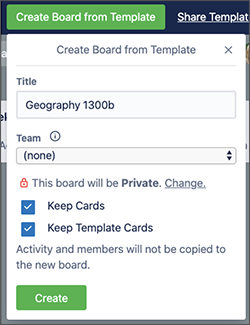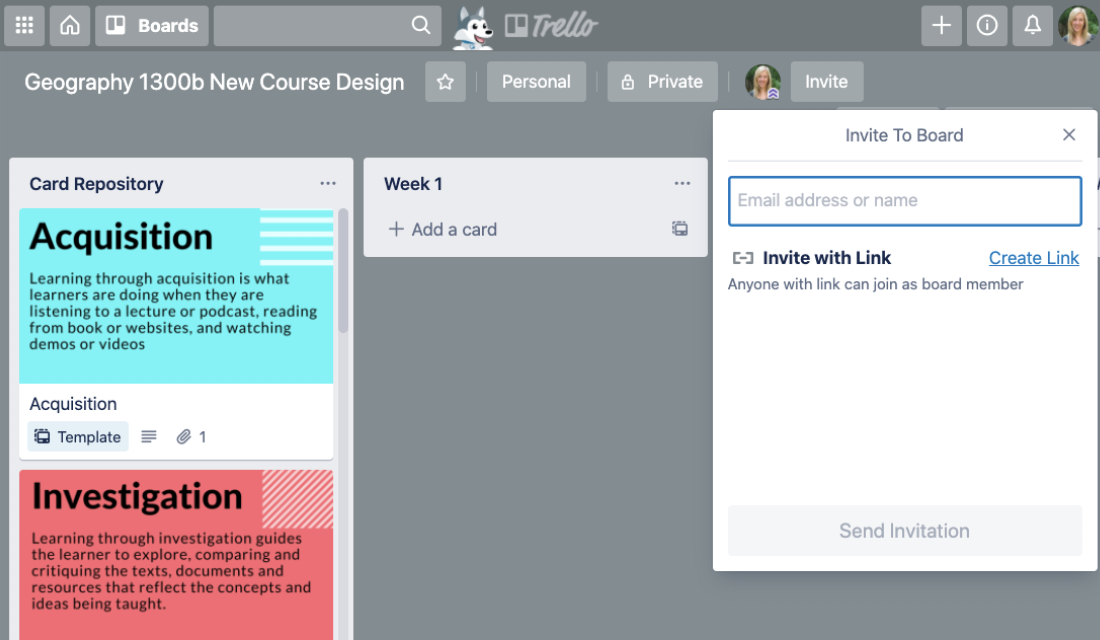Part 1: Defining Course Learning Types
This module is available for anyone interested in completing the ABC Online Course Design process on their own. We have also made it available for anyone who has attended our sessions and would like to review the process or share it with colleagues.
The purpose of Part 1: Define Course Learning Types is to:
- Introduce you to the Learning Types used in storyboarding,
- Map and reflect on the learning types you currently use in your course
- Prepare you for the storyboarding activity in Trello, including learning about some features and getting your own account and empty board set up.
After Part 1, continue with “Part 2: Independent Storyboarding.”
Defining Course Learning Types
In this activity, you will learn about learning types.
After completing the activity, you will have:
- A visual representation of the learning types in your course
- A reflection on the learning types represented in your course
Review the Learning types and some example activities below.
Learning through acquisition is what learners are doing when they are listening to a lecture or podcast, reading from books or websites, and watching demos or videos.
Traditional activities
- Reading books, journals, papers
- Listening to lecture in class
- Watching lab demonstrations or simulations
Online activities
- Reading electronic documents or e-books (e-Reserves, D2L content, online journals)
- Listening to podcasts or streaming videos in short, digestible chunks (Ryecast, YouTube, LinkedIn Learning)
- Watching online simulations, labs, or animations
Learning through investigation guides the learner to explore, comparing and critiquing the texts, documents and resources that reflect the concepts and ideas being taught.
Traditional
- Using text-based study guides (textbooks, course packs)
- Analyzing the ideas and information in a range of materials and resources
- Using conventional methods to collect and analyze data
- Comparing texts
- Searching and evaluating information and ideas
Online
- Using digital study guides (e-books, open textbooks, eReserves)
- Analyzing the ideas and information in a range of digital resources
- Using digital tools to collect and analyze data (open data)
- Comparing digital texts (eReserve)
- Searching and evaluating information and ideas found online or in library databases
Learning through collaboration encompasses discussion, practice, and production. Building on investigations and acquisition, it is about learners taking part in the process of knowledge building together.
Traditional
- Small group project requiring face-to-face meeting
- Commenting on others’ input in a class discussion
- Building a joint output
Online
- Small group project work using D2L discussion forums, Google Drive, Google Meet, Zoom
- Commenting on others’ input through D2L discussion forums, Wordpress, or Google Drive
- Building a joint output on a topic in Google Drive or Wordpress
Learning through discussion requires the learner to articulate their ideas and questions, and to challenge and respond to the ideas and questions from the instructor and/or from their peers.
Traditional
- Tutorial sessions
- Seminars
- Discussion in groups
- Discussion in class
Online
- Asynchronous: D2L Discussion forum, Wordpress blog, Google Group
- Synchronous: Zoom, Google Meet
Learning through practice enables the learner to adapt their actions to a task or goal, and use the feedback they get from self-reflection, their peers, their instructor, or the activity itself to improve the result of their action in relation to the goal.
Traditional
- Practice exercises
- Labs
- Field trips
- Face-to-face role-play activities
Online
- Self-assessment tests (D2L Quizzes)
- Virtual labs
- Virtual field trips
- Online role play activities or simulations
Learning through production motivates the learner to consolidate what they have learned by articulating their current conceptual understanding and how they used it in practice.
Traditional
- Producing documents, e.g. statements, essays, reports
- Producing designs
- Presentations
Online
- Producing electronic documents (D2L, Google Drive)
- Creating designs (D2L, Google Drive, Wordpress)
- Presentations (Google Slides, voice over PowerPoint, Zoom, Google Meet)
Map Your Course Learning Types
Map your current course learning types using the learning types mapping tool (external link, opens in new window) , and save a copy of it for Part 2 of the workshop.
Reflect
Look at the map of your current course learning types and reflect on the following questions.
- Does this represent what I intended when I designed my course?
- Are there any learning types that are over- or under-represented?
- Are there any gaps I want to address?
Introduction to Storyboarding
In this section, you will
- Watch an introduction to the storyboarding process, and
- Watch an introduction to storyboarding in Trello
- Sign up for Trello and make your own copy of our template storyboard
Getting Started with Trello
We are using a tool called Trello for the storyboarding process. The tool is fairly intuitive, but creating a log-in and learning the basic functions of the tool ahead of time will make the storyboarding process go smoothly.
By the end of this section, you will be able to:
- Make an account and log in,
- Create a blank storyboard from our template,
- Add a new learning activity card,
- Move a learning activity card,
- Specify an instructional activity, and
- Add an assessment.
Make an account at trello.com
Go to trello.com and click "Sign Up" (or log-in if you already have an account).
Make a storyboard for your course
- Open the “ABC Online Course Design at Toronto Metropolitan University, (external link) " template.
- Click “Create board from template” at the top of the screen.
- Change the title to your course name, and make sure “Keep Cards” and “Keep Template Cards” are selected.

Share your board
You can share your board with colleagues in order to discuss your course design or to collaborate on a course together.
- Click "Invite" at the top of the screen.
- Enter an email address for your colleague and click "Send Invite" OR click "Create Link" and share the link with a group.

Storyboarding in Trello
Watch the following video for an introduction to storyboarding in Trello. You will have the opportunity to create your own storyboard for your course in our storyboarding workshop or independently in Part 2.
Congratulations, you've completed part 1 of ABC Online Course Design! You have in hand your learning outcomes, your syllabus, and a map of your current course learning types.
If you’re planning to continue with storyboarding on your own, continue to Part 2: Storyboarding Your Course.